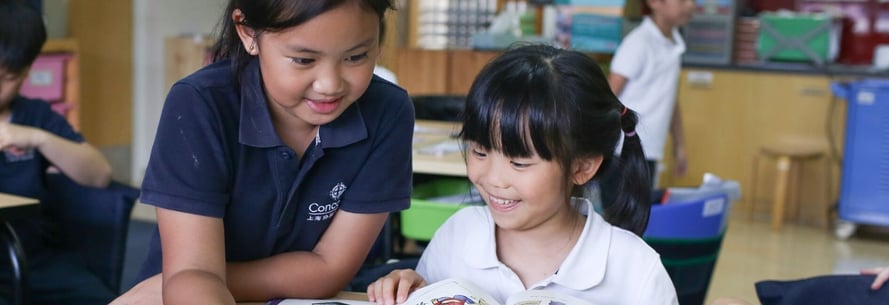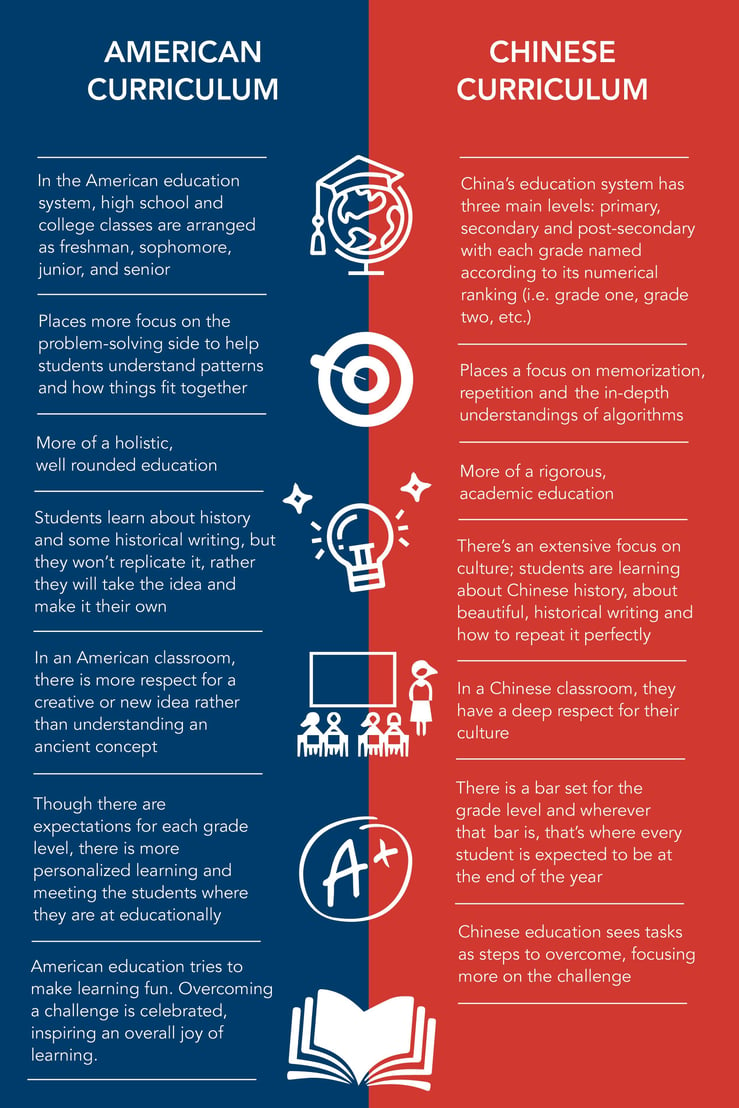
A comparison of Chinese and American education systems is an excellent way to gain a better understanding of each one while also helping you to identify which one will help your child get into an American university. While there are a number of similarities between Chinese and American education, they are different in many relevant ways.
One offers the knowledge of accumulation, is strict, and focused on building an educational foundation. The other encourages critical thinking, helps students develop skills for life, and focuses on the cultivation of creativity.
But which education system will actually help your child get into an American university? Read on to discover the differences and similarities between Chinese and American education systems and which one will help your children get into their best-fit university.
On the surface, it can appear as though Chinese and American education systems are as different as can be; where one focuses on rigidity and strictness, the other focuses on creativity and holistic pedagogy.
Below, we outline exactly what these similarities are when it comes to American and Chinese education systems.
What are the similarities between Chinese and American education

When selecting an international school, many parents have a difficult time understanding how Chinese and American education is similar when choosing which curriculum will be more beneficial to their children’s futures.
“I think too often we say one is better than the other when both have strengths [and similarities] and you can see that in the students who have been educated in one system versus another, they are all good at something. At an international school, you give them the chance to be good at two things. When deciding between the two, ultimately, it’s a personal choice,” says Genevieve Ermeling, Assistant Head of School in charge of teaching and learning.
We wanted to help you with this decision by outlining everything you need to consider when comparing Chinese and American education systems.
Students have similar attributes
When given the opportunity, students around the world show us how excited they are to learn. This is reflected in how hard they work to succeed and to reach their goals, and regardless of where they are from, parents want their children to receive as much knowledge and guidance out of their school system as they can.
Both Chinese and American students often reflect similar positive attributes that make them strong learners who are attractive to university admissions.
Students in both Chinese and American schools are hardworking and diligent, and while cultural influences may be different, the end result is very similar.
Though there are similarities between the two school systems, Chinese and American schools differ in many ways. To learn more about these differences, click here.
Parents are involved in their children’s education
Any parent knows that their children's education is crucial to their success, and this belief is the same no matter what your culture or where you’re located. Parents in both Chinese and American schools know the benefit of parents taking an active role in their children's education.
According to a study published by Child Trends, a website dedicated to researching ways to benefit the lives of children and youth, when one or more parents participate in parent organizations or parent/teacher conferences the student earns higher grades.
Another study published by the journal Early Child Development and Care found that Chinese parents specifically take a more academic focus in the household during times of transition for their children, and the result of this behavior is student academic performance is less impacted by the change.
Both systems report high graduation and post-secondary rates
Both American and Chinese cultures value academic achievement, and this value is reflected by the high graduation rate and high rate of students attending postsecondary institutions.
According to the National Centre for Education Statistics, the U.S. high school graduation rate in 2019 was 86%, and the organization also reports the rate of U.S. student enrollment in post-secondary programs has been steadily increasing over the past decade.
Similarly, in China, the graduation rate was 83.5% in 2017 according to the World Education News + Review, with many of those students gaining admission to post-secondary.
According to Genevieve Ermeling, our Assistant Head of School in charge of teaching and learning, these two curriculums truly are complementary to one another with more commonalities than what people initially see.
“Sometimes on the surface, there are more similarities than people realize, but we spend more time in different areas,” said Ermeling. “I think too often we say one is better than the other, when both have strengths and you can see that in the students who have been educated in one system versus another, they are all good at something. At an international school, you give them the chance to be good at two things.”
And when it comes to selecting an international school for your children and deciding between the two curriculums that will better help them excel, it’s also important to truly understand what each offers.
Click the link below to inquire with Concordia's Admissions department and learn more about the educational opportunities available for your child.
Differences Between Chinese and American education systems
On the surface, it can appear as though Chinese and American education systems are as different as can be; where one focuses on rigidity and strictness, the other focuses on creativity and holistic pedagogy.
Below, we have created a comparison of Chinese and American education systems.
The American education system
The American education system is known for its personalized, holistic approach that focuses on the development of the whole child.
Find out more about American classroom culture.
In the U.S., all students are guaranteed a free public education from kindergarten through grade 12.
Specifically, at Concordia Shanghai, our comprehensive American curriculum provides students with their own unique balance of Global Citizenship, Servant Leadership, Spirited Athleticism, Confident Artistry, and Passionate Scholarship.
At a glance:
- Language of American instruction: English
- Grades: preschool 3 to grade 12
- Academic year: mid-August to mid-June
- Compulsory education: age 16 to 19, depending on the state
Find out more about the American education system here.
The Chinese education system
Known for its academic rigor and the focus on challenge, Chinese education utilizes a meritocratic approach to teaching and learning with a heavy emphasis on examinations, grades, and, ultimately, excellence.
Learners in the Chinese education system are disciplined, look to the teacher as the sole knowledge source, and focus on memorization. Where Western education places importance on class participation and discussions, Chinese classrooms place more emphasis on the teacher imparting knowledge to the learners with little room for collaboration.
This is just one of the differences between the two curriculums, find out more here.
According to the Organisation for Economic Co-operation and Development (OECD) in their report exploring education in China, the goal of the Chinese education system “is to promote all-round development of students. Emphasis is placed on the moral, intellectual, and physical development of students in order to cultivate moral virtues, discipline, culture, and ideals.”
At a glance:
- Language of Chinese instruction: Mandarin, though in certain schools and/or locations, English, Cantonese, or Portuguese may accompany this primary language.
- Compulsory education: Completion of grade 9
- Academic year: September to July
Find out more about the Chinese education system here.
American curriculum vs Chinese curriculum

Which education will help your children get into their best-fit university, American or Chinese education?
“Chinese culture maybe a little too difficult and American may be too easy, but at Concordia Shanghai, we have the perfect balance where it’s challenging, but students are equipped with the knowledge and necessary steps to work through the problem,” says Ermeling.
To answer which curriculum looks better on a college application, it ultimately comes down to a personal decision. You need to select a school where your children will excel, where they will love what they’re learning because the more they enjoy the curriculum and subject matter, the more engaged they will be, and the more engaged they are, the better their grades will be. If your children’s college application showcases them as someone who truly loves learning, it will look a lot more appealing to admissions.
By preparing for college in high school and understanding the differences between American and Chinese education systems and which one will benefit your child the most, your child will have what they need to get into their best fit university.
Click the button below to inquire with Concordia's Admissions department and learn more about the educational opportunities available for your child.






